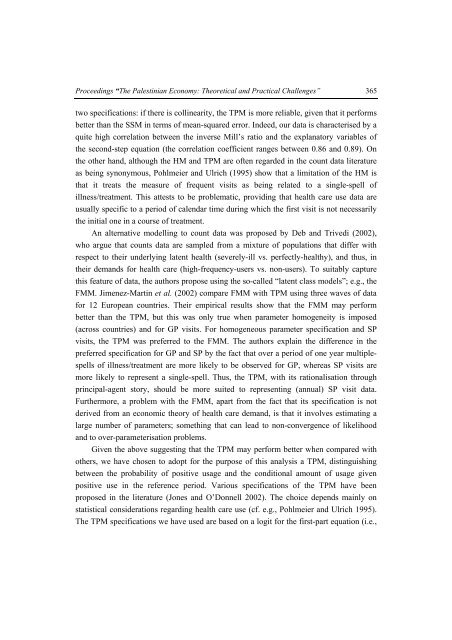The Palestinian Economy. Theoretical and Practical Challenges
The Palestinian Economy. Theoretical and Practical Challenges
The Palestinian Economy. Theoretical and Practical Challenges
You also want an ePaper? Increase the reach of your titles
YUMPU automatically turns print PDFs into web optimized ePapers that Google loves.
Proceedings “<strong>The</strong> <strong>Palestinian</strong> <strong>Economy</strong>: <strong>The</strong>oretical <strong>and</strong> <strong>Practical</strong> <strong>Challenges</strong>” 365<br />
two specifications: if there is collinearity, the TPM is more reliable, given that it performs<br />
better than the SSM in terms of mean-squared error. Indeed, our data is characterised by a<br />
quite high correlation between the inverse Mill’s ratio <strong>and</strong> the explanatory variables of<br />
the second-step equation (the correlation coefficient ranges between 0.86 <strong>and</strong> 0.89). On<br />
the other h<strong>and</strong>, although the HM <strong>and</strong> TPM are often regarded in the count data literature<br />
as being synonymous, Pohlmeier <strong>and</strong> Ulrich (1995) show that a limitation of the HM is<br />
that it treats the measure of frequent visits as being related to a single-spell of<br />
illness/treatment. This attests to be problematic, providing that health care use data are<br />
usually specific to a period of calendar time during which the first visit is not necessarily<br />
the initial one in a course of treatment.<br />
An alternative modelling to count data was proposed by Deb <strong>and</strong> Trivedi (2002),<br />
who argue that counts data are sampled from a mixture of populations that differ with<br />
respect to their underlying latent health (severely-ill vs. perfectly-healthy), <strong>and</strong> thus, in<br />
their dem<strong>and</strong>s for health care (high-frequency-users vs. non-users). To suitably capture<br />
this feature of data, the authors propose using the so-called “latent class models”; e.g., the<br />
FMM. Jimenez-Martin et al. (2002) compare FMM with TPM using three waves of data<br />
for 12 European countries. <strong>The</strong>ir empirical results show that the FMM may perform<br />
better than the TPM, but this was only true when parameter homogeneity is imposed<br />
(across countries) <strong>and</strong> for GP visits. For homogeneous parameter specification <strong>and</strong> SP<br />
visits, the TPM was preferred to the FMM. <strong>The</strong> authors explain the difference in the<br />
preferred specification for GP <strong>and</strong> SP by the fact that over a period of one year multiplespells<br />
of illness/treatment are more likely to be observed for GP, whereas SP visits are<br />
more likely to represent a single-spell. Thus, the TPM, with its rationalisation through<br />
principal-agent story, should be more suited to representing (annual) SP visit data.<br />
Furthermore, a problem with the FMM, apart from the fact that its specification is not<br />
derived from an economic theory of health care dem<strong>and</strong>, is that it involves estimating a<br />
large number of parameters; something that can lead to non-convergence of likelihood<br />
<strong>and</strong> to over-parameterisation problems.<br />
Given the above suggesting that the TPM may perform better when compared with<br />
others, we have chosen to adopt for the purpose of this analysis a TPM, distinguishing<br />
between the probability of positive usage <strong>and</strong> the conditional amount of usage given<br />
positive use in the reference period. Various specifications of the TPM have been<br />
proposed in the literature (Jones <strong>and</strong> O’Donnell 2002). <strong>The</strong> choice depends mainly on<br />
statistical considerations regarding health care use (cf. e.g., Pohlmeier <strong>and</strong> Ulrich 1995).<br />
<strong>The</strong> TPM specifications we have used are based on a logit for the first-part equation (i.e.,
















